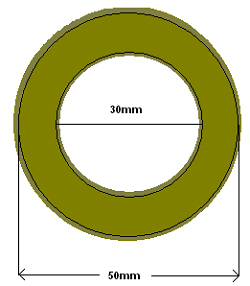#3D Printing is here, so that’s great news. But the fact of the matter is that we are still in the very early stages and I must say those who ‘print’ on a daily basis are truly aware of how much more the technology has to develop before it can truly be a game changer.
This is more so in the case of metal printing machines. Well to be fair, most metal printing machines are used in the industrial arena and it is fairly obvious that industries are far more stringent with regard to the final dimensions. One of the reasons why we see slow uptake of metal machines is because you don’t really get an end product from the machine. What you get is a ‘near net shape’ with material properties being close to conventional processes.
Regardless of the material that is used in metal printing, the accuracy of the component that 95% of the users achieve is usually in excess of 80µ from the specified dimensions. Have a look at the example below:
 The disk on the left has an external diameter of 50mm and an internal diameter of 30mm. But what actually gets printed is usually 50µ to 100µ excess both inside the ring and outside the ring. Therefore depending on the machine setting what you finally get is a component that has external diameter of 50.050mm and internal diameter of 29.950mm as against precise 50mm and 30mm.
The disk on the left has an external diameter of 50mm and an internal diameter of 30mm. But what actually gets printed is usually 50µ to 100µ excess both inside the ring and outside the ring. Therefore depending on the machine setting what you finally get is a component that has external diameter of 50.050mm and internal diameter of 29.950mm as against precise 50mm and 30mm.
In most cases this level of dimensional inaccuracy is accepted – especially if they are ‘prototypes’. In the case of functional components, these variations are not accepted. In most conventional machines, it is very easily possible to get accuracies where variations are less than 10µ. But unfortunately additive manufacturing of metal doesn’t allow us yet to get to that level of accuracy. The disclaimer here is that 95% of the machine users are still unable to get that level of accuracy – there are 5%, with deep domain expertise who have achieved single µ accuracy.
